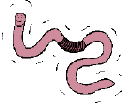|
|
|
|||||
|
|
||||||
|
||||||||||
|
Fast Growing Trees Fastest
Deciduous |
|
Faster
Deciduous |
|
Fast
Deciduous
Evergreen |
|
Fast Growing
Hedging Plants
Deciduous
Evergreen
Arborvitae
Douglas Fir |
 |
How to Make Compost to Gladden the Hearts of a Worm#3 - FAQs and Tips |
(# worms have 5 pairs of hearts |
|
Connected pages clay soil | extreme clay soil | plants for clay soil | compost 1 | compost 2 | compost 3 | improving the soil | pruning | soil types | the basics | Unwanted visitors |
|
Warning - Making garden compost can become addictive. In extreme cases, it is possible to see the garden as a being an elaborate means of keeping the compost heaps going. |
|
|
A. The usual reason is that there's not enough material added at one go. There needs to be a reasonable amount of fresh material added to get the temperature rising.
If you are adding a lot of material and it still isn't getting warm, the reason might be;
Not enough nitrogen - too much brown material, not enough green.
Q. My heap is slimy and smelly and quite disgusting.
A. Too many grass clippings or other soft green leaves is the usual reason. Mix them with brown material if possible. A good way of dealing with 2 problems is to mix the grass clippings in the summer with leaves left over from the autumn. If you have a separate leaf pile, then mix them a bit at a time with grass clippings as you get them and put them on your compost heap.
Alternately stop collecting grass clippings and leave them on the lawn instead.
Q. I've heard that urinating on a compost heap helps, is this true, or is it a joke?
A. Urine contains nitrogen that will help feed the microbes and speed up their break-down of the brown carbon-rich material. Also, the water content will help keep the heap moist. I regularly pee on my compost heap - but only when no-ones looking.
A. Initially when a compost heap begins to rot, it is microbes, bacteria and fungi that feed on it and break it down. This generates large amounts of heat, to the point where only microbes could even survive, larger decomposers such as worms would quite literally be cooked.
Later on after a few months, when the heating stage has subsided, larger decomposers such as earthworms, woodlice, and more familiar fungi that produce mushrooms of various kinds will begin to decompose the heap. It is during this stage that the matter in the heap becomes further processed, becomes less recognizable and becomes darker and more crumbly.
Q. What is better a traditional compost heap or a new style plastic compost bin?
If you don't have much space or produce much compost material, then a bin is probably better. They are very good at dealing with small amounts of material, retain heat well and keep the rain out. They do become full very quickly however if you have a lot of material to compost.
I use one for the initial hot-phase of compost making and would recommend them highly for this. Put new material in the bin and then let it rot down, and keep adding to the bin until full. Leave for another month after it' s full and then turn upside down onto a more traditional heap, leaving for a further 6 to 8 months before using, and start again in the bin. You should be able to fill the bin with about 3 times its volume over a period of time which would then decrease (to 1) before moving the semi-rotted material to the heap.
This is a common problem. Grass clippings can make very good compost but not on their own. Mix them if at all possible with other woody (brown) material. You could mix them autumn leaves if you have a pile of these somewhere rotting away slowly, this will be beneficial for both. You could even try an equal volume of newspaper torn up into strips and mixed in, though I haven't actually tried this method.
The worst thing you can do with grass clippings is what people often do and put them in a black bin liner that is then tied tight so that no oxygen can enter, making the whole smelly horrible mess all the more unpleasant.
Alternatively, do you really need to always collect the clippings? In the summer when the grass is dry and fairly short, you could leave them on the lawn to dry out and rot down, or even buy a "mulching lawn mower"
Q. What is the best thing to with all the piles of autumn leaves that I sweep up from my garden.
One approach is to put them in a post and wire mesh container and let them rot down alone to make leaf mould which is an excellent conditioner, though takes at least a year before it's ready and realistically will be in the spring of the second year after the leaves are swept up in the first place. This also requires a fair amount of space for long-term storage.
You could save them until the following spring / summer and mix them with rich green material such as grass clippings (above).
One tip I heard, though have not tried is to half-fill a large tub with (preferably dry) leaves and then cut them up using a strimmer. This would help to break them down more quickly whatever you then did with them subsequently.
|
|
|
About us. General queries and emails to |
|
Copyright © Paul Ward 2000 - 2012 |